Rohit Sinha
Exploring the Task-agnostic Trait of Self-supervised Learning in the Context of Detecting Mental Disorders
Mar 22, 2024Abstract:Self-supervised learning (SSL) has been investigated to generate task-agnostic representations across various domains. However, such investigation has not been conducted for detecting multiple mental disorders. The rationale behind the existence of a task-agnostic representation lies in the overlapping symptoms among multiple mental disorders. Consequently, the behavioural data collected for mental health assessment may carry a mixed bag of attributes related to multiple disorders. Motivated by that, in this study, we explore a task-agnostic representation derived through SSL in the context of detecting major depressive disorder (MDD) and post-traumatic stress disorder (PTSD) using audio and video data collected during interactive sessions. This study employs SSL models trained by predicting multiple fixed targets or masked frames. We propose a list of fixed targets to make the generated representation more efficient for detecting MDD and PTSD. Furthermore, we modify the hyper-parameters of the SSL encoder predicting fixed targets to generate global representations that capture varying temporal contexts. Both these innovations are noted to yield improved detection performances for considered mental disorders and exhibit task-agnostic traits. In the context of the SSL model predicting masked frames, the generated global representations are also noted to exhibit task-agnostic traits.
Analyzing the Effect of Data Impurity on the Detection Performances of Mental Disorders
Aug 09, 2023Abstract:The primary method for identifying mental disorders automatically has traditionally involved using binary classifiers. These classifiers are trained using behavioral data obtained from an interview setup. In this training process, data from individuals with the specific disorder under consideration are categorized as the positive class, while data from all other participants constitute the negative class. In practice, it is widely recognized that certain mental disorders share similar symptoms, causing the collected behavioral data to encompass a variety of attributes associated with multiple disorders. Consequently, attributes linked to the targeted mental disorder might also be present within the negative class. This data impurity may lead to sub-optimal training of the classifier for a mental disorder of interest. In this study, we investigate this hypothesis in the context of major depressive disorder (MDD) and post-traumatic stress disorder detection (PTSD). The results show that upon removal of such data impurity, MDD and PTSD detection performances are significantly improved.
Exploring the Role of Emotion Regulation Difficulties in the Assessment of Mental Disorders
Aug 04, 2022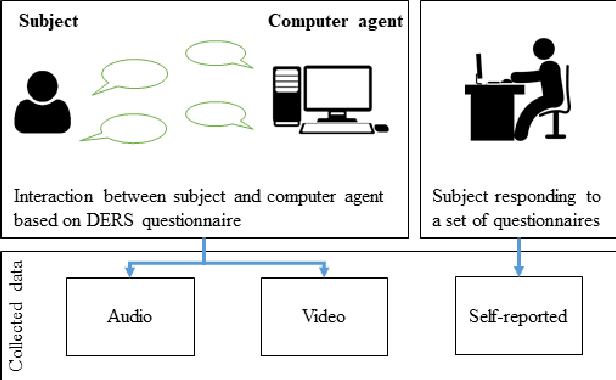
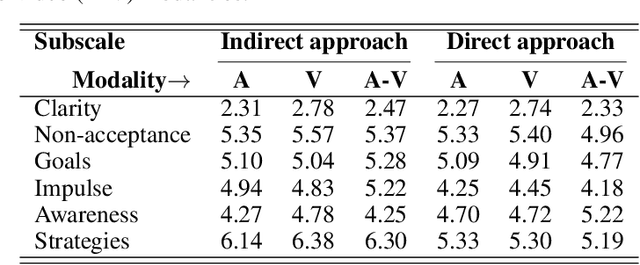
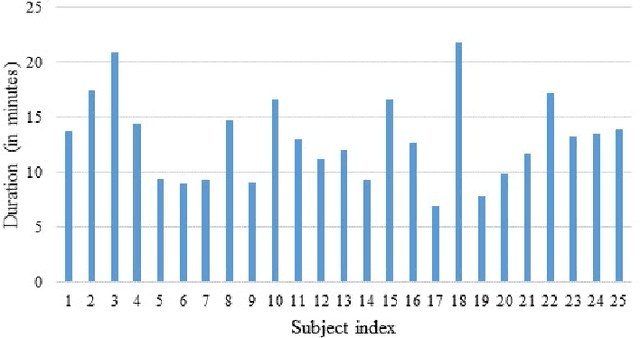
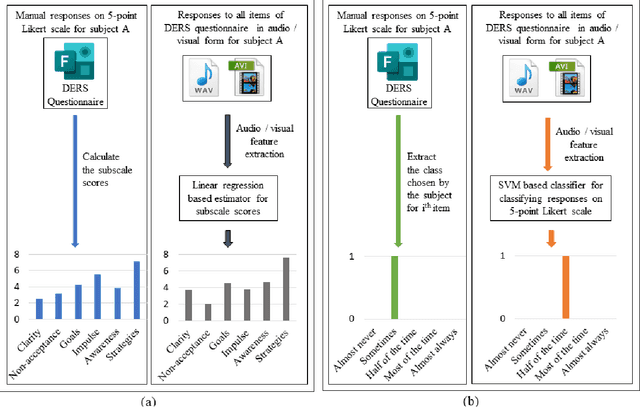
Abstract:Several studies have been reported in the literature for the automatic detection of mental disorders. It is reported that mental disorders are highly correlated. The exploration of this fact for the automatic detection of mental disorders is yet to explore. Emotion regulation difficulties (ERD) characterize several mental disorders. Motivated by that, we investigated the use of ERD for the detection of two opted mental disorders in this study. For this, we have collected audio-video data of human subjects while conversing with a computer agent based on a specific questionnaire. Subsequently, a subject's responses are collected to obtain the ground truths of the audio-video data of that subject. The results indicate that the ERD can be used as an intermediate representation of audio-video data for detecting mental disorders.
Significance of Data Augmentation for Improving Cleft Lip and Palate Speech Recognition
Oct 02, 2021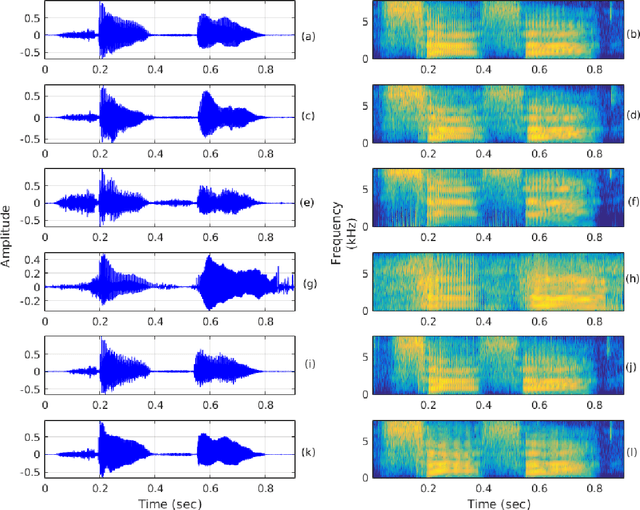
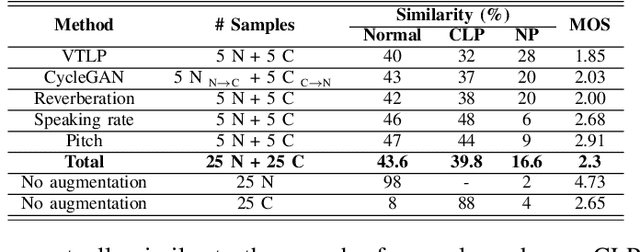
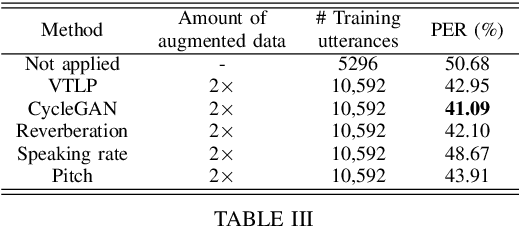
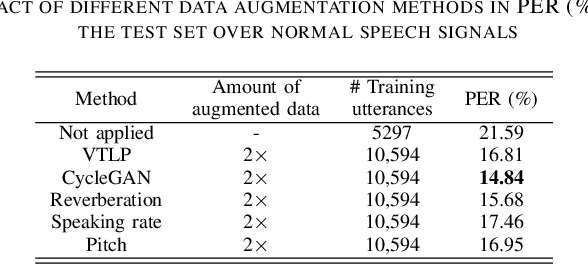
Abstract:The automatic recognition of pathological speech, particularly from children with any articulatory impairment, is a challenging task due to various reasons. The lack of available domain specific data is one such obstacle that hinders its usage for different speech-based applications targeting pathological speakers. In line with the challenge, in this work, we investigate a few data augmentation techniques to simulate training data for improving the children speech recognition considering the case of cleft lip and palate (CLP) speech. The augmentation techniques explored in this study, include vocal tract length perturbation (VTLP), reverberation, speaking rate, pitch modification, and speech feature modification using cycle consistent adversarial networks (CycleGAN). Our study finds that the data augmentation methods significantly improve the CLP speech recognition performance, which is more evident when we used feature modification using CycleGAN, VTLP and reverberation based methods. More specifically, the results from this study show that our systems produce an improved phone error rate compared to the systems without data augmentation.
Processing Phoneme Specific Segments for Cleft Lip and Palate Speech Enhancement
Oct 02, 2021



Abstract:The cleft lip and palate (CLP) speech intelligibility is distorted due to the deformation in their articulatory system. For addressing the same, a few previous works perform phoneme specific modification in CLP speech. In CLP speech, both the articulation error and the nasalization distorts the intelligibility of a word. Consequently, modification of a specific phoneme may not always yield in enhanced entire word-level intelligibility. For such cases, it is important to identify and isolate the phoneme specific error based on the knowledge of acoustic events. Accordingly, the phoneme specific error modification algorithms can be exploited for transforming the specified errors and enhance the word-level intelligibility. Motivated by that, in this work, we combine some of salient phoneme specific enhancement approaches and demonstrate their effectiveness in improving the word-level intelligibility of CLP speech. The enhanced speech samples are evaluated using subjective and objective evaluation metrics.
Enhancing the Intelligibility of Cleft Lip and Palate Speech using Cycle-consistent Adversarial Networks
Jan 30, 2021



Abstract:Cleft lip and palate (CLP) refer to a congenital craniofacial condition that causes various speech-related disorders. As a result of structural and functional deformities, the affected subjects' speech intelligibility is significantly degraded, limiting the accessibility and usability of speech-controlled devices. Towards addressing this problem, it is desirable to improve the CLP speech intelligibility. Moreover, it would be useful during speech therapy. In this study, the cycle-consistent adversarial network (CycleGAN) method is exploited for improving CLP speech intelligibility. The model is trained on native Kannada-speaking childrens' speech data. The effectiveness of the proposed approach is also measured using automatic speech recognition performance. Further, subjective evaluation is performed, and those results also confirm the intelligibility improvement in the enhanced speech over the original.
Investigating Target Set Reduction for End-to-End Speech Recognition of Hindi-English Code-Switching Data
Jul 15, 2019



Abstract:End-to-end (E2E) systems are fast replacing the conventional systems in the domain of automatic speech recognition. As the target labels are learned directly from speech data, the E2E systems need a bigger corpus for effective training. In the context of code-switching task, the E2E systems face two challenges: (i) the expansion of the target set due to multiple languages involved, and (ii) the lack of availability of sufficiently large domain-specific corpus. Towards addressing those challenges, we propose an approach for reducing the number of target labels for reliable training of the E2E systems on limited data. The efficacy of the proposed approach has been demonstrated on two prominent architectures, namely CTC-based and attention-based E2E networks. The experimental validations are performed on a recently created Hindi-English code-switching corpus. For contrast purpose, the results for the full target set based E2E system and a hybrid DNN-HMM system are also reported.
Joint Language Identification of Code-Switching Speech using Attention based E2E Network
Jul 15, 2019



Abstract:Language identification (LID) has relevance in many speech processing applications. For the automatic recognition of code-switching speech, the conventional approaches often employ an LID system for detecting the languages present within an utterance. In the existing works, the LID on code-switching speech involves modelling of the underlying languages separately. In this work, we propose a joint modelling based LID system for code-switching speech. To achieve the same, an attention-based end-to-end (E2E) network has been explored. For the development and evaluation of the proposed approach, a recently created Hindi-English code-switching corpus has been used. For the contrast purpose, an LID system employing the connectionist temporal classification-based E2E network is also developed. On comparing both the LID systems, the attention based approach is noted to result in better LID accuracy. The effective location of code-switching boundaries within the utterance by the proposed approach has been demonstrated by plotting the attention weights of E2E network.
Hindi-English Code-Switching Speech Corpus
Sep 24, 2018



Abstract:Code-switching refers to the usage of two languages within a sentence or discourse. It is a global phenomenon among multilingual communities and has emerged as an independent area of research. With the increasing demand for the code-switching automatic speech recognition (ASR) systems, the development of a code-switching speech corpus has become highly desirable. However, for training such systems, very limited code-switched resources are available as yet. In this work, we present our first efforts in building a code-switching ASR system in the Indian context. For that purpose, we have created a Hindi-English code-switching speech database. The database not only contains the speech utterances with code-switching properties but also covers the session and the speaker variations like pronunciation, accent, age, gender, etc. This database can be applied in several speech signal processing applications, such as code-switching ASR, language identification, language modeling, speech synthesis etc. This paper mainly presents an analysis of the statistics of the collected code-switching speech corpus. Later, the performance results for the ASR task have been reported for the created database.
Language Modeling for Code-Switched Data: Challenges and Approaches
Nov 09, 2017



Abstract:Lately, the problem of code-switching has gained a lot of attention and has emerged as an active area of research. In bilingual communities, the speakers commonly embed the words and phrases of a non-native language into the syntax of a native language in their day-to-day communications. The code-switching is a global phenomenon among multilingual communities, still very limited acoustic and linguistic resources are available as yet. For developing effective speech based applications, the ability of the existing language technologies to deal with the code-switched data can not be over emphasized. The code-switching is broadly classified into two modes: inter-sentential and intra-sentential code-switching. In this work, we have studied the intra-sentential problem in the context of code-switching language modeling task. The salient contributions of this paper includes: (i) the creation of Hindi-English code-switching text corpus by crawling a few blogging sites educating about the usage of the Internet (ii) the exploration of the parts-of-speech features towards more effective modeling of Hindi-English code-switched data by the monolingual language model (LM) trained on native (Hindi) language data, and (iii) the proposal of a novel textual factor referred to as the code-switch factor (CS-factor), which allows the LM to predict the code-switching instances. In the context of recognition of the code-switching data, the substantial reduction in the PPL is achieved with the use of POS factors and also the proposed CS-factor provides independent as well as additive gain in the PPL.
 Add to Chrome
Add to Chrome Add to Firefox
Add to Firefox Add to Edge
Add to Edge